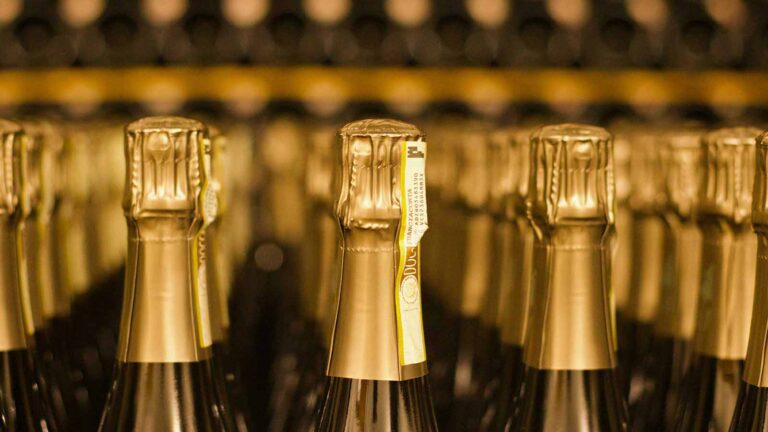Rosés can be produced in a variety of ways with the most common method being early pressing of red grape varieties after a very short period, usually 12–24 hours, of skin contact (maceration). During maceration, phenolics such as the anthocyanins and tannins that contribute to colour as well as many flavour components are leached from the skins, seeds and any stems left in contact with the must. In addition to adding colour and flavour, these phenolics also serve as antioxidants, protecting the wine from degradation by oxygen exposure. While red wines will often have maceration last several days to even several weeks, the very limited maceration of rosés means that these wines will have less stable colour, potential flavour components and oxygen protection. This contributes to wines with shorter shelf-life that are meant to be consumed soon after release.
The saignée (French for “bleed”) method is the practice of removing (“bleeding off”) some of the juice from the must in order to more deeply concentrate the phenolics, colour and flavour of the red wine. It has a long history of use in the French wine regions of Bordeaux and Burgundy but wasn’t always used for rosé production. For some red winemakers, the juice bleed off is simply poured down the drain or used as “topping wine” to fill the ullage (the headspace of barrels and tanks) during storage.
Its use in rosé production is sometimes considered an afterthought, as a way to increase cash-flow by producing a second wine to a primary red wine that can be released much sooner and available to market. While many wineries have been able to produce critically acclaimed rosé using the saignée method, its use has provoked criticism from wine personalities such as François Millo, president of the Provence Wine Council (CIVP) who claim that saignée method rosés are “not true rosés” because the bleeding process (which is not pressed with the must) is more of an ‘after-thought’.
Unlike the maceration method which gives some, albeit very brief, time for the juice to be in contact with the skins vin gris are wines made from the immediate pressing of red skin grapes without any maceration time. Despite the name vin gris, the resulting juice is actually not grey but rather a very pale pink that is usually much lighter than traditionally made rosés using the limited maceration and saignée methods. Under French wine laws, wines labelled gris de gris must only be made from lightly tinted grape varieties such as Cinsault, Gamay and Grenache gris. The style is a specialty of the Lorraine Appellation d’Origine Contrôlée (AOC) Côtes de Toul made from Gamay and in Morocco where the orange-pink wine is made from a blend of Cinsault, Grenache and Cabernet Sauvignon.
Another method of producing rosé that is to severely decolourize a red wine using absorbent charcoal such as activated carbon. This purer form of charcoal obtained by the dry distillation of carbon compounds (such as wood or peat) has a high ratio of surface area to weight that absorbs colour compounds as well as other phenolics and colloids in a wine. While it can be used to decolourize a wine, often much more than just colour is stripped from the wine which makes this method very rarely used in the production of quality rosés.
Rosés can come in a variety of colours depending on the grape variety and method of production.
With the exception of very few varieties, known as teinturiers, most wine grapes produce clear or colourless juice. This includes such well known red wine grape varieties such as Cabernet Sauvignon and Pinot Noir. The colour of red wine comes from phenolics in the skin called anthocyanins that react with other components in wine (such as tannins, acetaldehyde and pyruvic acid) to form polymeric pigments. The anthocyanins are extracted from the skin during the process of maceration which can last from a few hours in the case of some rosés (which usually only have 20–50 mg/l of anthocyanins) to several days in the case of most red wines (which often have in excess of 250 mg/l of anthocyanins).
Anthocyanins have the ability to change into three different forms—colourless, red and blue—depending on the pH/acidity levels of the solution they are in. At wine pH (typically 2.9-4.0), most of the grape anythocyanins are in the colourless form unless they have reacted with tannins or other molecules (such as tannins also extracted from the skin as well as grape seeds, stems and from oak wine barrels) to form a stabilized pigment. So producers wishing to make rosé work to not only limit the amount of anthocyanins extracted into the wine but also limit the wines exposure to tannins (either by less maceration time, gentle pressing of the grapes or use only stainless tanks instead of oak) as well as protective anti-oxidative winemaking techniques that limit the development of acetaldehyde and other browning pigments that could add colour to the wine.
Many studies have shown that the colour of wine influences consumer’s perceptions about the wine. While these studies have shown that consumers tend to prefer on visual inspection the darker rosés, in blind taste tests where colour could not be visually discerned (such as using black wine glasses), often consumers preferred the lighter-coloured rosés.
For these reasons, many rosé winemakers are mindful of the colour quality of their rosé and make winemaking decisions based on this factor. This includes the extent of maceration, whether or not to do a saignee from a darker red wine and even to do a colour adjustment by blending in some finished red wine in order to reach the desired colour.
Many of the aroma and flavour components in wine are located in the skin. The length of maceration (where the must is in contact with the skin) will influence how much of these compounds are extracted and available in the wine.
The aromas and flavour of rosés are primarily influenced by the particular grape varieties used to produce the wine but the method of production also plays an important part. The light, fruity character of many rosés, comes from volatile thiols that are found as flavour precursors in the grape skins. The most prominent of these is 3-mercaptohexanol-1-ol and 3-mercaptohenyl acetate. These are extracted from the grape’s skin during maceration but are less likely to be extracted at temperatures before 20 °C (68 °F). So producers doing a “cold soak” maceration (with a much lower temperature) to limit microbial and oxidative activity may extract less of these compounds. During fermentation, other flavour components such as the esters phenethyl acetate and isoamyl acetate also form and contribute to wine’s aromas.
The stability of these aromas is very dependent on the amount of anthocyanins and other phenolics that protect these compounds from oxidation. One of the reasons why rosés have such a very limited shelf-life is because of their low phenolic levels due to the very limited skin contact and extraction time. Usually within a year of production, the levels of 3-mercaptohexanol-1-ol in the wine have dropped to half its fermentation levels with the presence of 3-mercaptohenyl acetate undetectable in most wines. This is why most wine experts recommend that rosés are consumed as soon as possible after release.








